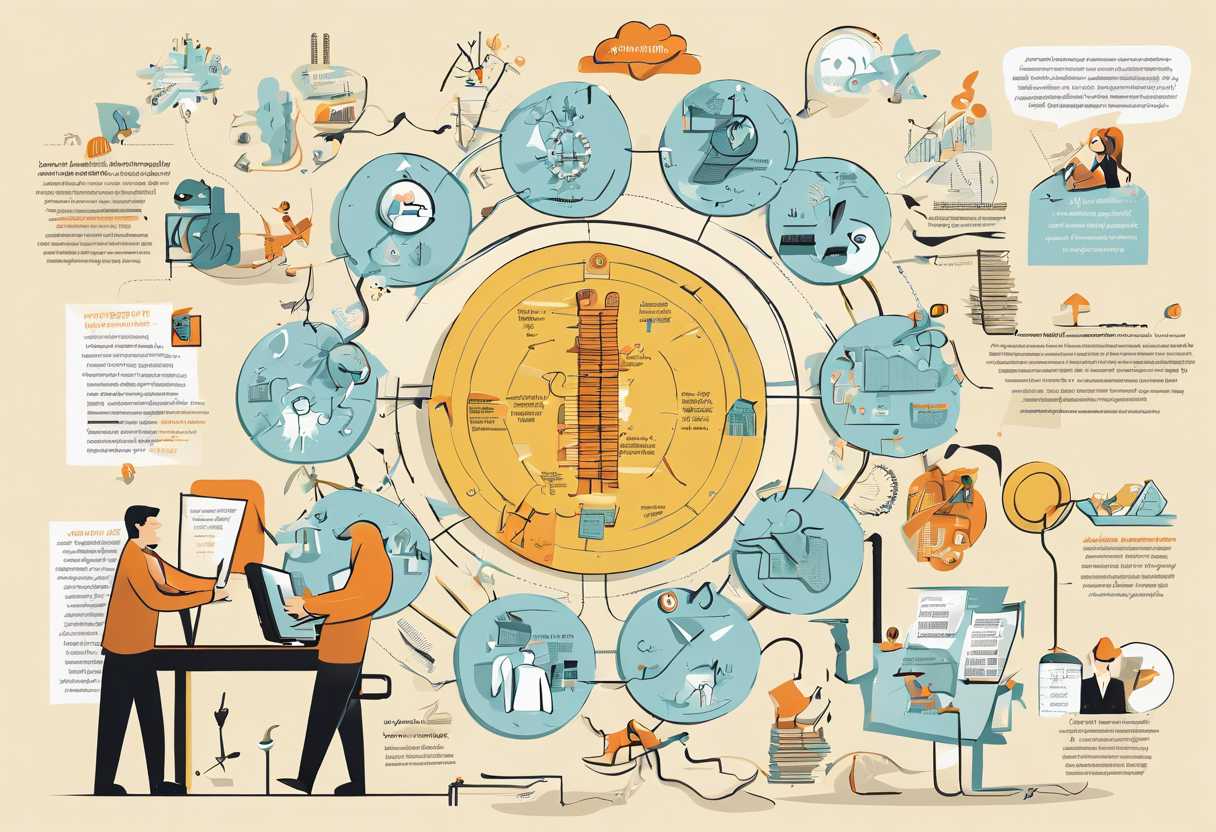Are you curious about the Agile Manifesto and its impact on project management and development processes? In this comprehensive blog post, we will delve into the key principles of the Agile Manifesto and their significance, as well as explore how it has evolved and its relevance in today’s business environment. We will also discuss best practices for implementing the Agile Manifesto and common challenges that organizations may face. By the end of this post, you will have a thorough understanding of what the Agile Manifesto indicates and how it can shape the way you approach projects and processes. So, let’s dive in and explore the world of Agile Manifesto together.
Understanding the Agile Manifesto: A Comprehensive Overview
The Origins of the Agile Manifesto
The Agile Manifesto was created in 2001 by a group of software developers who were frustrated with the traditional, rigid approach to software development. They sought to find a better way to develop software that would be more responsive to change and deliver better results for their clients. The result was the Agile Manifesto, which outlines a set of values and principles for agile software development.
The Four Values of the Agile Manifesto
The Agile Manifesto is based on four core values:
- Individuals and interactions over processes and tools
- Working software over comprehensive documentation
- Customer collaboration over contract negotiation
- Responding to change over following a plan
These values emphasize the importance of people and their interactions, the need for working software, the value of collaboration with customers, and the ability to adapt to change.
The Twelve Principles of the Agile Manifesto
In addition to the four core values, the Agile Manifesto also includes twelve principles that provide further guidance for agile software development. These principles include:
- Customer satisfaction through early and continuous delivery of valuable software
- Welcome changing requirements, even late in development
- Deliver working software frequently, with a preference to the shorter timescale
- Business people and developers must work together daily throughout the project
- Build projects around motivated individuals, give them the environment and support they need, and trust them to get the job done
- The most efficient and effective method of conveying information to and within a development team is face-to-face conversation
- Working software is the primary measure of progress
- Agile processes promote sustainable development
- The sponsors, developers, and users should be able to maintain a constant pace indefinitely
- Continuous attention to technical excellence and good design enhances agility
- Simplicity–the art of maximizing the amount of work not done–is essential
- The best architectures, requirements, and designs emerge from self-organizing teams

Key Principles of the Agile Manifesto and Their Significance
The Agile Manifesto
The Agile Manifesto is a set of guiding principles for software development that emphasizes flexibility, collaboration, and customer satisfaction. It was created in 2001 by a group of software developers who were frustrated with the traditional, rigid approach to software development. The Agile Manifesto consists of four key values and twelve principles that are designed to help teams work more efficiently and effectively.
Key Principles of the Agile Manifesto
1. Individuals and interactions over processes and tools: This principle emphasizes the importance of people and their interactions in the software development process. It highlights the value of communication, collaboration, and teamwork over relying solely on processes and tools.
2. Working software over comprehensive documentation: This principle prioritizes the delivery of working software over extensive documentation. It encourages teams to focus on creating functional, usable software that meets the needs of the customer.
3. Customer collaboration over contract negotiation: This principle emphasizes the importance of involving the customer in the development process. It encourages collaboration and feedback from the customer throughout the project, rather than relying on rigid contracts and negotiations.
Significance of the Agile Manifesto Principles
The principles of the Agile Manifesto are significant because they promote a more flexible, adaptive approach to software development. By prioritizing individuals and interactions, working software, and customer collaboration, teams can deliver higher quality products that better meet the needs of the customer. These principles also help teams to be more responsive to change, as they emphasize adaptability and continuous improvement throughout the development process.

How Agile Manifesto Impacts Project Management and Development Processes
Agile Principles in Project Management
Agile manifesto has significantly impacted project management by promoting a flexible and iterative approach to project execution. The four core values of the Agile manifesto – individuals and interactions over processes and tools, working software over comprehensive documentation, customer collaboration over contract negotiation, and responding to change over following a plan – have revolutionized project management methodologies. By prioritizing customer satisfaction, embracing change, and fostering collaboration, Agile principles have led to more efficient and effective project management processes.
Agile Methodologies in Development Processes
Agile manifesto has also revolutionized development processes by advocating for adaptive planning, evolutionary development, early delivery, and continuous improvement. Agile methodologies such as Scrum, Kanban, and Extreme Programming have gained popularity due to their emphasis on delivering high-quality software in a timely and flexible manner. By breaking down complex projects into smaller, manageable tasks and promoting frequent feedback and adaptation, Agile methodologies have transformed the traditional approach to software development.
Impact on Team Dynamics and Productivity
The Agile manifesto has had a profound impact on team dynamics and productivity. By promoting self-organizing, cross-functional teams and encouraging open communication and collaboration, Agile has fostered a culture of transparency, trust, and accountability within development teams. This has led to improved productivity, higher quality deliverables, and increased customer satisfaction. Additionally, Agile’s emphasis on continuous improvement and reflection has empowered teams to identify and address inefficiencies, leading to a more efficient and effective development process.
The Evolution of Agile Manifesto
Agile Manifesto, originally created in 2001, has undergone significant evolution over the years. It has transformed from a set of principles for software development to a philosophy that has permeated various industries and business functions. Let’s take a closer look at how the Agile Manifesto has evolved and its relevance in today’s business environment.
From Software Development to Business Agility
Initially, the Agile Manifesto was primarily focused on improving the efficiency and effectiveness of software development processes. However, as businesses began to recognize the benefits of agility, the principles of the Agile Manifesto were adapted to other areas of business, such as marketing, project management, and even human resources. Today, the concept of business agility has become synonymous with the Agile Manifesto, emphasizing the importance of adaptability, collaboration, and customer-centricity in all aspects of an organization.
Relevance in Today’s Business Environment
In today’s rapidly changing business environment, the principles of the Agile Manifesto are more relevant than ever. With the increasing pace of technological advancements, shifting consumer preferences, and global market dynamics, businesses need to be agile to stay competitive. The Agile Manifesto provides a framework for organizations to embrace change, respond to uncertainty, and deliver value to their customers in a timely manner. By adopting agile practices, businesses can improve their ability to innovate, reduce time-to-market, and enhance overall customer satisfaction.
Implementing Agile Manifesto: Best Practices and Common Challenges
Best Practices for Implementing Agile Manifesto
When implementing the Agile Manifesto, it is important to follow best practices to ensure success. One key practice is to prioritize customer collaboration over contract negotiation. This means actively involving the customer in the development process and seeking their feedback regularly. Another best practice is to embrace change and be flexible in responding to it. This requires a mindset shift towards adaptability and a willingness to make adjustments as needed. Additionally, fostering a collaborative and self-organizing team is crucial for Agile success. This involves empowering team members to make decisions and work together towards common goals.
Common Challenges in Implementing Agile Manifesto
Despite its benefits, implementing the Agile Manifesto comes with its own set of challenges. One common challenge is resistance to change within the organization. This can manifest as pushback from team members who are accustomed to traditional methods and are hesitant to adopt Agile practices. Another challenge is the need for strong leadership and support. Without buy-in from leadership, it can be difficult to drive the necessary changes and sustain Agile practices. Additionally, maintaining a balance between speed and quality can be a challenge in Agile implementation. The focus on delivering value quickly can sometimes lead to compromises in quality if not managed effectively.
Overall, implementing the Agile Manifesto requires a commitment to best practices and a proactive approach to addressing common challenges. By prioritizing customer collaboration, embracing change, and fostering a collaborative team environment, organizations can overcome obstacles and reap the benefits of Agile methodologies.
Conclusion
In conclusion, the Agile Manifesto serves as a guiding light for organizations looking to embrace a more flexible and collaborative approach to project management and development. By understanding the key principles and their significance, businesses can effectively adapt to the evolving demands of today’s business environment.
As we’ve explored, the impact of the Agile Manifesto on project management and development processes is undeniable. Its emphasis on individuals and interactions, working solutions, customer collaboration, and responding to change has revolutionized the way projects are executed and delivered.
Furthermore, the evolution of the Agile Manifesto has ensured its continued relevance in today’s fast-paced and dynamic business landscape. By implementing best practices and addressing common challenges, organizations can harness the full potential of Agile methodologies to drive innovation and success.
As you navigate the world of Agile, remember that embracing the Agile Manifesto is not without its challenges. However, with dedication and a commitment to continuous improvement, businesses can unlock the true power of Agile and thrive in an ever-changing market.
Ultimately, the Agile Manifesto indicates a shift towards a more adaptive, customer-centric, and collaborative approach to project management and development. By embracing its principles and best practices, businesses can position themselves for sustained success in the digital age.
Thank you for joining us on this journey through the Agile Manifesto. We encourage you to apply these insights to your own projects and share your experiences with us. Together, let’s continue to drive innovation and excellence through Agile methodologies.

